817 Search Results for praactical teaching
November 29, 2012
by Carole Zangari -
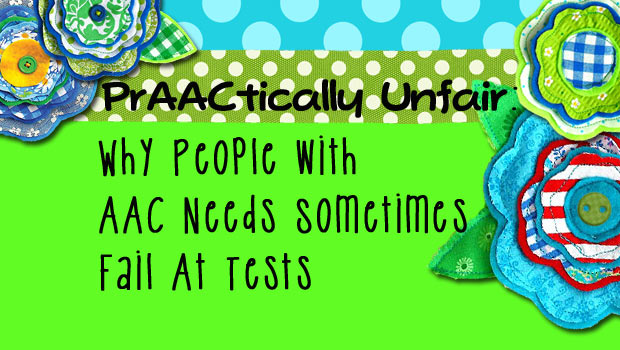
What do these situations have in common? Renting a car with a new GPS system to drive to an interview in a foreign city Hosting a dinner party and cooking a gourmet meal in someone else’s kitchen Using new software to deliver a presentation at a conference If you said they all create anxiety, you’re right. But here’s something else: They all require you to do something unfamiliar or difficult and learn a new tool at the same time and produce results under stressful conditions. We would never put our AAC learners under such stress and expect them to perform well, would we? Of course not! Except when we: Ask them to use an AAC device/app that they are still learning to answer test questions Require them to use a new or exhausting motor pattern to produce a written product for grading Expect students without sufficient test-taking skills to demonstrate... [Read More...]
November 20, 2012
by Carole Zangari -
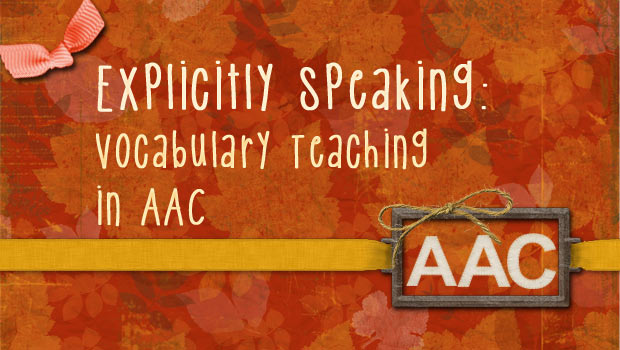
An essential part of the model we shared for AAC semantic intervention is Step 2, teaching the new words with explicit instruction activities. In our posts, explicit instruction refers to the process of designing and using carefully planned sequence of empirically-supported teaching activities. Though focused on reading, not vocabulary, development, this PowerPoint presentation by Dr. Anita Archer gives an excellent overview of the characteristics of explicit instruction. In our initial teaching of new words, we to be sure that the learners have frequent opportunities to respond: Active participation is critical at this point. We have to give the learner a lot of opportunities to say the word (e.g.,“resume”) and tell about it (e.g., “keep going,” “start again and not stop,” “verb”, etc.). We want to elicit a lot of responses so that we can monitor their performance. That allows us to provide feedback that is affirmative when the learners respond... [Read More...]
November 12, 2012
by Carole Zangari -
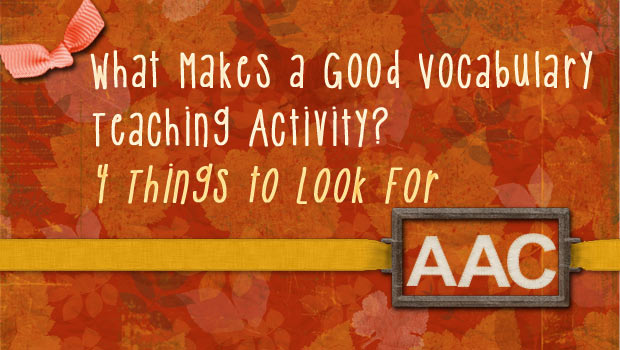
This post is a follow-up to some others in which we introduced a general sequence of how we conceptualize semantic instruction and then went on to discuss the initial step in more detail. Today, we’ll be talking more about Step 2, Teaching the new word(s) with explicit instruction activities. There are so many creative ways to teach new word meanings, but for this step in the process we stick with those that meet a few basic criteria. Guidelines for Creating or Selecting Activities to Teach New Words Rich context: As we’ve said before, context reigns supreme. The cognitive, social, and linguistic cues that children use to learn new word meanings change over time, but at every stage they derive meaning from the surrounding context. Using contextual cues makes us more efficient learners and so it is something we want to encourage in our AAC learners. For a beginning communicator, a... [Read More...]
November 8, 2012
by Carole Zangari -
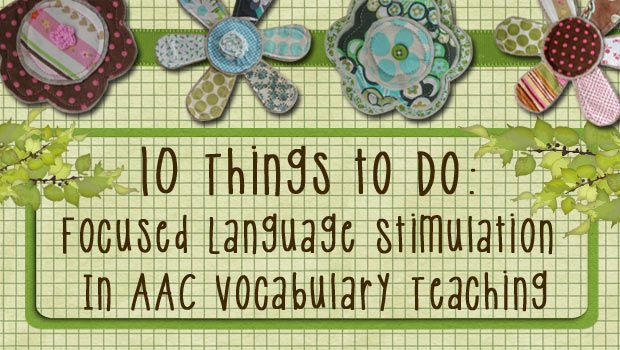
All this month we are talking about considerations in teaching new words to people who use AAC. We’ve talked about the role of focused aided language stimulation and wanted to follow that up with a few more ideas for implementing this strategy. Select the new (target) word to teach giving consideration to Tier 2 words that fit with their language or curriculum goals. Pronounce it. Provide a student-friendly definition Use aided language input: Model the word on the device if it is stored in there OR use the device to explain the new word in a student-friendly way. Find ways to use it throughout the day (and beyond). Hearing the word in various contexts is a great way to deepen the learner’s understanding. Have the AAC learners say it using their AAC (e.g., spelling it out on SGD) or natural speech. Segment it. (E.g., “One of our new words is... [Read More...]
November 7, 2012
by Carole Zangari -
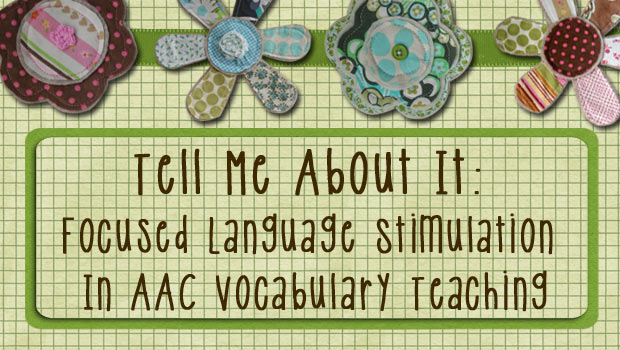
Earlier this month, we introduced a general sequence of how we conceptualize semantic instruction. We promised to elaborate on that. There are two things that I really love about this approach to to vocabulary teaching. The first is that is honors a principle that we know to be true: providing repetition with variety not only helps us reach learners with different strengths, but also gives our AAC learners much-needed practice. The other thing that makes this really work for us is that assessment has an active role but not a central one. Testing takes a backseat to teaching. As we all know, getting accurate assessment information from people who are learning their AAC systems is a huge challenge. Often, our AAC friends don’t have decent test-taking skills so we’re not really testing what we think we’re testing. Just last week I got to see Kristofer, an adorable little fellow who... [Read More...]
October 30, 2012
by Carole Zangari -
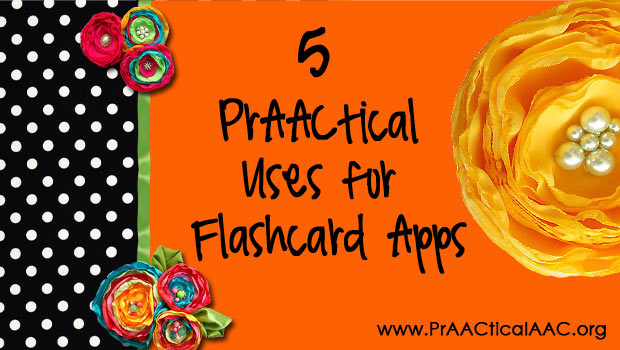
We love AAC intervention that begins and ends with a context that is meaningful to the learner. Not only is contextually relevant therapy more engaging and fun for the learner (thus, easier on the clinician!) but it promotes generalization to real-world contexts. So we’ve never been terribly fond of therapy that uses flash cards, or, more recently, the digital versions on iOS or Android devices. It’s a shame, really. There are a lot of those kinds of apps, and many of them have great graphics. That got us to starting thinking: What could we use them for that improves real communication and AAC learning? PrAACtical Uses for Flashcard Apps Make a Mini Schedule: Lots of people with AAC needs use paper-based picture schedules that depict the activities they do throughout the day. A flashcard app could be used in conjunction with those to show the steps or parts of an... [Read More...]
October 9, 2012
by Carole Zangari -
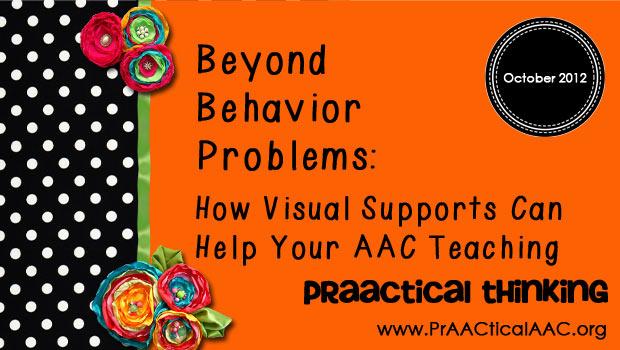
Visual supports are not just for people with behavioral challenges. In this post, we share some ideas of using visual schedules and other supports to enhance comprehension and language learning. Let’s look put this into a clinical context. Marvin is a high school student with intellectual disabilities and cerebral palsy who is learning to use a high tech SGD. He is a personable young man who engages easily and comes to each session with a ‘ready to learn’ mindset. Most of Marvin’s goals revolve on learning to build sentences using core words. Although he has very limited literacy skills, he really, really wants to learn word prediction. This presented a bit of a dilemma, as I typically don’t begin to teach word prediction until spelling skills are approaching the third grade level. Marvin has some terrific splinter skills but his overall spelling skills are probably around the mid-first grade level.... [Read More...]
October 8, 2012
by Robin Parker -
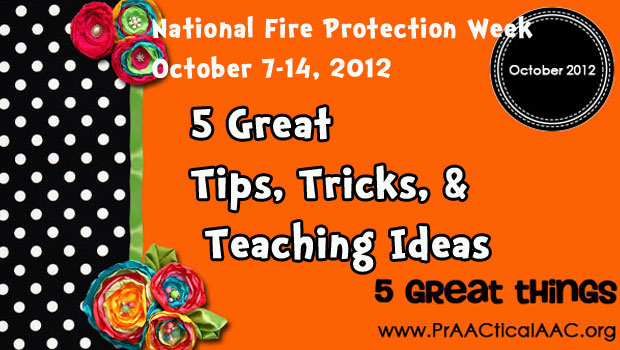
It is National Fire Protection Week October 7-13, 2012. Check Out These 5 Great Tips, Tricks, and Teaching Ideas: Sensory Breaks & Learning Activities Firefighters are being Educated in Auburn On-Line Fire Safety Games for Kids How To Teach and Present Information, Lesson Plans, and Visual Supports for children and adults with Intellectual Disabilities For Teachers and SLPS
July 14, 2012
by Robin Parker -
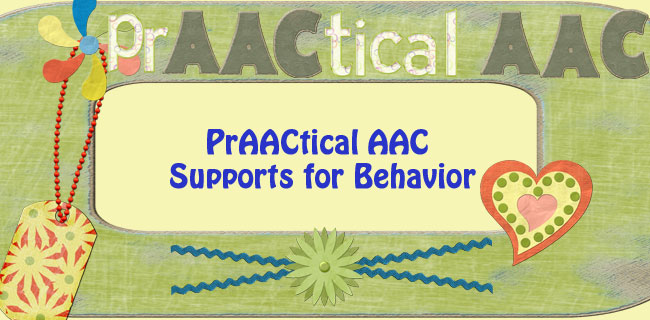
Our July Strategy of the Month, PrAActical AAC Supports for Behavior, is a favorite topic for us, because with a little planning, we can adhere to the old adage that an ‘ounce of prevention is worth a pound of cure’ (as Carole said last week). We also find that behavior challenges are often one of the main reasons, our students (and colleagues) get stressed about working with children with significant communication impairments. And since stress for ANYONE does not make for an optimal learning environment, we love to show how effective preventative strategies work. This week we are focusing on ‘setting the stage’ for conventional and appropriate behavior by engineering the physical environment. We are talking about more than keeping the room neat, clean, and generally organized. We are talking about arranging the physical environment in a planned and careful way in order can make a huge difference in helping... [Read More...]
July 6, 2012
by Robin Parker -
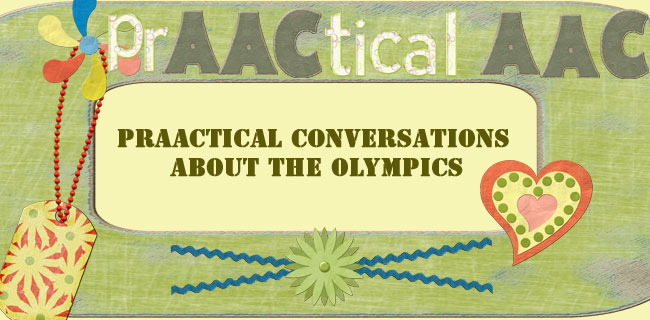
It’s not too early to begin. It seems that everyone is talking about the London 2012 Olympics. The Olympic conversation is an interesting teaching and learning platform for almost any communication and language goals. It is fun, educational, and most importantly, most smaller and larger ‘communities’ will have Olympic images, videos, television shows, and conversation. There will soon be Olympic immersion. You can TALK and TEACH before the Olympics start, while they are happening, and even after they are over. It is easy to include ALL learners at ALL levels with these free resources that do the time-consuming preparation work for you. Just use your language facilitation strategies and have fun! News 2 You London 2012 Olympics Widget Free Pack- Olympics 2012 Primary Treasure Chest- Olympic Printable Free Resources **Bonus- we often also use these resources for home programming because our clinic is closed... [Read More...]









